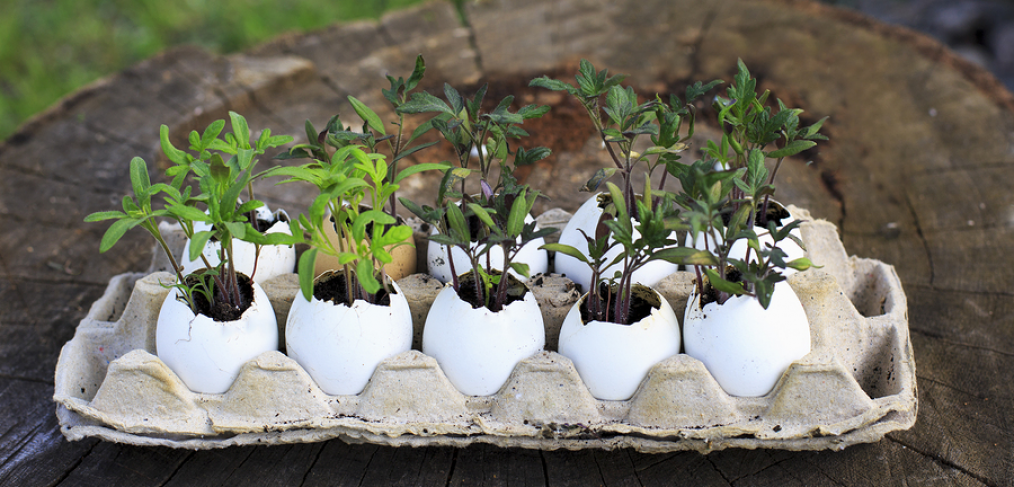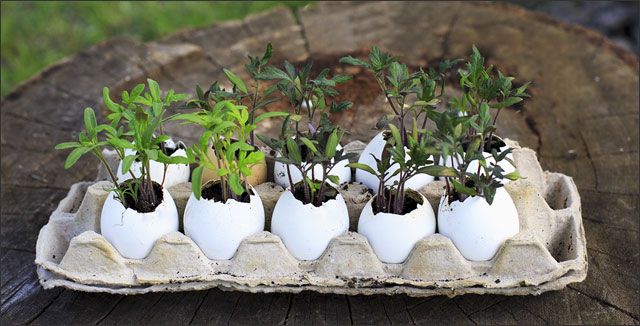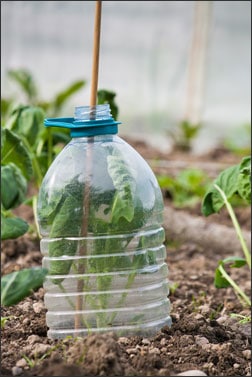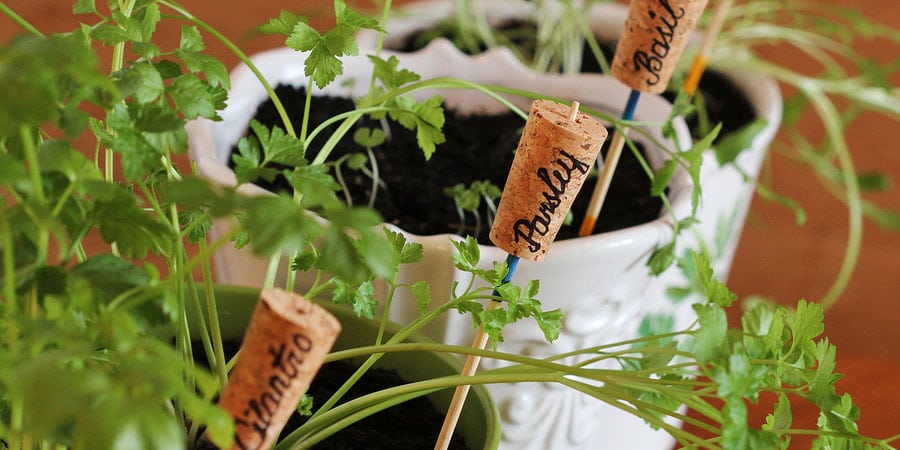
45 Cost-Effective Gardening Tips & Tricks

Whether you are a novice or veteran gardener, the season of gardening is here. How do you minimize your time outdoors so that you can maximize your time indoors?
Here are 45 cost-effective gardening tips and tricks to make your green thumb greener from preventing dirt from getting under your fingernails to drying herbs and finding practical uses for discarded coffee and tea grounds.
#1: How to Keep Your Fingernails Clean
Are you tired of dirty nails while gardening? Just rub your nails across a bar of soap. This will seal the underneath tips of your fingernails. After you finish gardening, take a nail brush to remove the soap leaving your nail nice and clean.
#2: Natural Looking Garden Markers
Write down the name of the plant on a rock with a permanent marker to create natural looking tags.
#3: How to Rid Yourself of Aphids
Here are a few tricks to rid your plants from aphids:
- Use insecticidal soap.
- Hit them with a strong blast of water.
- Take tape and wrap it around your hand sticky side up with your hand pat the underside of the leaf.
#4: Reuse Water from Boiled Vegetables
Do not throw out the water after boiling or steaming your veggies. Instead, pour the nutrient-rich cooled liquid into your potted patio plants. They will love you for it.
#5: An Easy Way to Discourage Small Animals
Fork your own lawn! Just kidding, but if you put plastic forks, tines up, near your small plants, it will discourage little pests like bunnies from eating them.
#6: Recycle Your Coffee and Tea Grounds
You may not like the acidity of coffee or tea, but rhododendrons, gardenias, blueberries, and azaleas LOVE acidity. Take your used coffee and tea grounds and sprinkle 1 1/4 of an inch around the plants once a month to keep the pH levels on the acidic side.
#7: How to Ripen Green Tomato
Near the end of the season when the first frost is about to hit, what do you do with all of those green tomatoes? Just pull up the whole vine and hang it up inside. The tomatoes will ripen right on the vine!
#8: Try Companion Planting
Try companion planting if you’ve never done it before. Many plants have complementary nutrient needs, and others keep pests away.
For more, please see Companion Planting: Three Sisters Native American Garden
#9: Splash Your Garden Tool Handles With Paint
Give the handles of your garden tools a splash of bright paint so you won’t lose them in the middle of your garden.
#10: Use a Calendar
Write a note in your calendar to compost 2-3 weeks before planting, as it needs time to integrate into and stabilize in the soil.
#11: Compost in the Fall
Better yet, and easier on your back, apply a layer of compost to the garden in the fall right after the last harvest. Cover the entire garden with mulch mixture like hay or chopped leaves and leave nature to do the work for you. The melting snow and organisms in the soil will work in the compost for you.
#12: Vine Vegetables and Fruits
Save space by training all of your vining vegetables and fruits – like squash, melons, cucumbers, and zucchini – onto a vertical trellis. It looks cool and saves a ton of space.
#13: Harvest Promptly
Harvest your garden vegetables promptly to avoid attracting pests.
#14: When to Harvest Onions
You will know onions are ready to be harvested when their tops fall over. Let the soil dry out before you collect them and then store in the dark where it’s dry until the tops dry out. Once you cut off the heads, store them in a cool, dry area.
#15: How to Keep Dirt off Salad Greens and Control Weeds
Want to keep the dirt off of your salad greens and the weeds under control? Put a couple of inches of mulch around each plant but make sure it’s not treated with chemicals.
#16: How to Give a Boost to a Transplanted Flower or Vegetable Plant
If you’re transplanting a flower or vegetable plant, put a handful of compost into the hole first to give it an extra boost.
#17: How to Create a Natural Fence to Ward Off Insects
Insects hate the scent of garlic, onions, chives, and mums, so make these plants your edible fence to keep the pests out.
#18: How to Easily Protect Plants From Frost

Plastic bottle being used as a cloche
Cut milk jugs and pop bottles, as well as other plastic containers, into mini cloches to help protect your plants from frost.
#19: Easiest Way to Start Pea
The easiest way to start peas is indoors. They germinate better, the seedlings are healthier, and they have a better chance of fighting off pests and disease when you do this.
#20: Cut Down on Pesticides
Cut down on your need for pesticides by making sure your soil is healthy. Healthy soil makes healthy plants that can fight off disease.
#21: Invite Earthworms
Earthworms love natural and organic fertilizers like compost. And earthworms are very beneficial to your garden. They provide increased air space in the soil for growing roots and leave behind their castings, which plants love.
#22: Use Natural Insecticide
Diatomaceous earth, or bentonite clay, makes an excellent natural insecticide and slug barrier. It’s abrasive to bugs’ skin, joints and cuticles, but it’s great for homemade beauty products as well – like natural deodorant.
#23: Know Your Veggies
Do you know which veggies sweeten up after a good, hard frost? Kale, cabbage, parsnips, Brussels sprouts, and carrots.
#24: Tips for Transplanting Tomato Plants
If you are transplanting a tomato plant, plant it right up to the first set of leaves to encourage growth and make it into a stronger, healthier plant.
#25: Encourage Healthy Soil
Healthy soil has “good tilth” when it hosts a diverse and thriving population of earthworms, microbes, and other organisms. Plants grown in this soil will thrive.
#26: Increase Your Soil’s Compost
If you increase your soil’s compost matter by only 5%, it will quadruple its ability to hold water.
#27: How to Avoid Spreading Mildew and Other Fungal Diseases
Avoid spreading mildew and other fungal diseases by watering your garden in the early morning.
#28: Tips for Garlic, Shallots, and Leaks
Always have a supply of garlic, shallots, and leeks by planting them in pots. They have shallow roots and are pest resistant.
#29: Watering Tips
It’s easier to revive a dry plant than to dry out a drowned one. Don’t over water.
#30: Recycle Egg Shells
Break up egg shells around the base of your plants to discourage small bugs and pests and to slowly add calcium to the soil.
#31: How to Warm up Your Soil
Warm up your soil and extend your growing seasons by anchoring black plastic sheeting to your garden for a week before you plant.
#32: Wrap up Your Tomatoes
Use plastic wrap to help insulate your tomato plants in colder weather. It creates a mini greenhouse around each plant and makes your tomatoes want to grow fast!
#33: Garden Tool Caddy
Have an old golf bag? They work great as a garden tool caddy.

Wine cork markers
#34: Use Wine Corks as Garden Markers
Garden markers are indispensable. Leftover wine corks can be easily marked. Stick them on a fork or wood skewer. Then, place them into the ground by your plants.
#35: An Easy DIY Watering Can
Poke holes into the lid of an old milk jug to use as a DIY watering can for sprinkling your seedlings.
#37: Use Binder Clips
Use binder clips to fasten row covers to protect your young plants from cold weather and pests.
#38: Beach Caddy to Wash Vegetables
Use a beach caddy to wash your vegetables outside right after you harvest them. If you put this inside a bucket, you can also save the water you use to water your garden!
#39: Diapers to Retain Moisture
Use a diaper at the bottom of your potted plants to help retain moisture.
#40: Use That Old Mailbox
Use your old mailbox near your garden to store garden tools.
#41: Seedling Trays for Free
Local gardening stores will often give away seedling trays for free, just ask.
#42: Use Eggshells to Start Seeds
You can also start seeds in eggshells. Starting your own seeds saves a ton of money.
#43: Citrus Peels for Seed Starters
Citrus peels make good seed starters too. You don’t even have to transplant your seedlings. Just stick them in the ground with the peel when they are ready.
#44: Recycle Rubbermaid Containers
Have a bunch of Rubbermaid containers with the lids broken or missing? Drill holes in the bottom for a container garden that’s deep enough for almost anything.
#45: How to Quickly Dry Herbs
Are you looking to dry your herbs quickly? Put them on newspaper in a single layer, lay the paper on the seat of your car and close the windows. Not only will your car smell great but the herbs will dry perfectly.
Bringing it Home
Hopefully, these practical cost-effective gardening tips and tricks will make your thumb greener and your garden flourish.
Do you know any gardening tips or tricks that we did not mention? We would love to hear them. Please share your thoughts in the comment section below.




Enjoyed reading your tips. Always looking for new or better ideas. Thx.
Hi Brenda,
I’m glad to hear you enjoyed the tips. Thank you for commenting!
~ Jeff